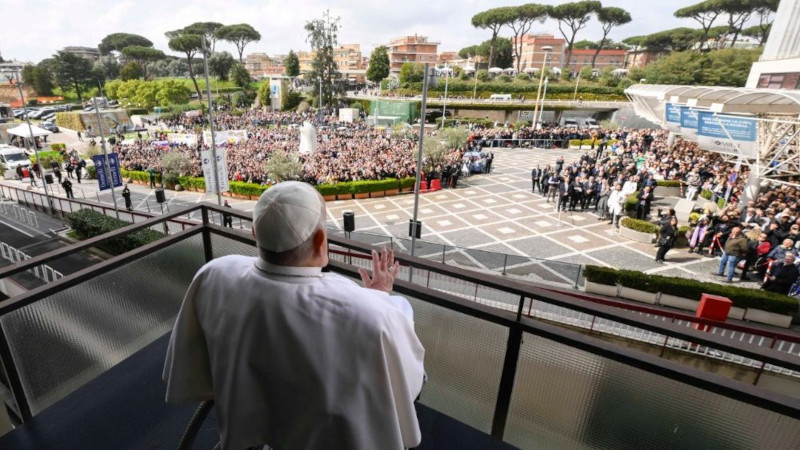
Pope Francis discharged from Gemelli Hospital
After 39 days of hospitalization at “Gemelli,” Pope Francis faces, greets, blesses and stretches his thumbs up to the 3,000 cheering people on Sunday, March 23
Doctors discharge him and on his return to the Vatican he makes a stop at St. Mary Major to thank Our Lady. On Sunday, March 16, the 32nd day of his hospitalization, he had concelebrated in the small chapel of the “Gemelli
SATURDAY, MARCH 22 – The Vatican Press Office informs that the following day at noon he will appear at the little balcony of the polyclinic for a greeting and blessing at the end of the Angelus of the Third Sunday of Lent. It is a moment that cheers Argentine Cardinal Víctor Manuel Fernández, prefect of the dicastery for the Doctrine of the Faith and a friend of the Pope’s: “I knew that his organism could react and at the end he is well physically. It will take rehabilitation because after so long with oxygen everything dries up and you have to learn to speak again but the organism is like before. A new stage begins and he is a man of surprises.”
GOOD CONDITION – Polyclinic doctors speak of “improvement since two weeks, long convalescence of at least two months: he will have to wait before resuming normal activity. Major infections have been defeated and some seizures have been dangerous.” Health officials advise against meetings with groups and individuals. Sergio Alfieri, director of the Department of Medical and Surgical Sciences and director of the team that followed him, and Luigi Carbone, deputy director of Vatican Health and the Pontiff’s referring doctor narrate the long hospitalization for bilateral polymicrobial pneumonia, the life-threatening crises: “The good news is that he will return to Santa Marta.” They summarize what has happened since Feb. 14 when he presented “with acute respiratory failure due to a polymicrobial infection. Viruses, bacteria and mycetes resulted in severe bilateral pneumonia that required combined drug treatment.”
HE RISKED GREATLY – Adds Alfieri: “Two very critical episodes affected Francis, who was in mortal danger.Pharmacological therapies, high-flow oxygen administration, and noninvasive mechanical ventilation showed slow and progressive improvement, bringing him out of the most critical episodes.He has never been intubated and has always remained alert, oriented and present.Discharge occurs in stable condition for at least two weeks.He must partially continue drug therapies for a long time to come.Important is a rest period in convalescence for at least two months.”
A “protected discharge.” Dr. Carbone informs, “No special facility or special room has been set up but all needs have been assessed, the same as for all patients discharged for pneumonia. A health care in Santa Marta with a 24-hour service for any emergency.” What about speech difficulties? “Bilateral pneumonia damages the lungs and the respiratory muscles are in trouble. You lose your voice a little bit.” As with all patients young and old, especially the elderly, “it will take time for the voice to return to what it used to be.” A curiosity: “We have not weighed him, however, he has lost weight. The robe fits him large. He is writing and feeding himself.”
COMMENTS CANCELLED – Added Alfieri and Carbone: “Of the resignation he had been hoping for some time.
For 3-4 days he had been asking us, ‘When am I going home?’He has been an exemplary patient, listening to everyone’s suggestions.One morning, like every morning, we went to auscultate his lungs.We asked him, “How are you?”He replied, “I’m still alive.”We understood that he had regained his good spirits.”Doctors believe “it was the right time, also because the hospital, it may sound strange to say, is the worst place for convalescence, because it is the place where you get the most infections.”No word on the meeting with King Charles (April 8); the Holy Week and Easter celebrations (April 20); the canonization of Charles Acutis (April 27); and especially the much-desired trip to Nicaea (in Asia Minor, 100 kilometers from Istanbul, with Patriarch Bartholomew of Constantinople for the 1700th anniversary of the Council (May 24).
“THANK YOU TO EVERYONE” – Before facing the balcony, Francis greeted doctors, staff and the top management of the Catholic University and Policlinico Gemelli, including the rector of the ‘Cattolica,’ Elena Beccalli.A few words, his face tried, his hands on his knees.A hint of a smile on seeing the crowd shouting, “Francis, Francis.We love you.A curiosity: “We have not weighed him, however, he has lost weight.The robe fits him large.
In the courtyard-square there are nurses, doctors, students from the University; people of various nationalities.
There is a group – Vatican media inform – “that from St. Peter’s Square harnessed the Jubilee cross and arrived at ”Gemelli.”
There are Emanuela and Adam, with their three children: “We prayed every day for him, it was right for them to see him.”
In the text of the “Angelus” she speaks of conversion; she stresses the care of the health care personnel; she expresses sorrow for the resumption of the bombing of Gaza; she hopes for the Azerbaijan-Armenia agreement; she implores an end to the wars, in the tormented Ukraine, in Palestine, Israel, Lebanon, Myanmar, Sudan, Democratic Republic of Congo.”
He gets driven to St. Mary Major to give thanks to the “Salus populi romani.”Without getting out of the car he hands flowers to Cardinal Rolandas Makrickas to place at the foot of the icon.For Cardinal Matteo Maria Zuppi, president of the Italian Episcopal Conference, “in his long hospitalization he showed us ‘the blessing that is hidden within fragility’ and from the chair of the hospital he reminded us how necessary ‘the miracle of tenderness’ is.”
John Paul II was hospitalized several times at “Gemelli.”The longest stays were: May 13-June 3, 1981 because he was seriously wounded by Turkish terrorist Mehemet Ali Agca; June 20-August 14, 1981 new hospitalization for megalovirus from blood transfusion after the attack.
